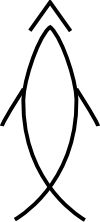Like the Sumerians and the Egyptians, the Harappans inhabited a fertile river valley (this one in Pakistan) in around 3300 BC. Like in the Middle East, the Harappans developed a sophisticated civilization. Like in the Middle East, the Harappans put symbols on many things, though they took 500 years longer than the Middle Easterners. Unlike in the Middle East, it is not clear if those symbols were writing or not.
Like Vinca, the collections of symbols in “Indus script” or “Harappan script” are short. The longest “phrase” is only 17 characters long, and the average string is only 5 characters long. If it is a writing system, it is undoubtedly logographic due to the number of distinct glyphs — 417 found so far.
Most of the glyphs have been found on what appear to be seals. It might be that the symbols are arbitrary symbols that people used to claim ownership or creation of a work, in much the same way that Facebook profile photos claim ownership and creation of status messages.
Indus appears to not have been influenced by other scripts, but it is quite possible that they got the idea of writing (or making symbols, if it is not writing) from elsewhere. They had been writing in the Middle East for about five hundred years by the time they started making their symbols, and five hundred years is a long time. Five hundred years is only slightly less than the time between Gutenberg’s printing press and moon shots, and there is evidence of indirect trade routes between Pakistan and Egypt in the Harappan time period. (Essentially all lapis lazuli comes from Afghanistan, and there are lapis lazuli artifacts in both Egyptian and Indus archeological sites of that time period.)
I suspect that no messages were sent from Cairo to Karachi. Papyrus was expensive (and could be re-used); clay was heavy. Even more important, what’s the use of sending a letter to someone who couldn’t read in a language they didn’t speak?
It is possible that a trader brought along writing supplies for his own personal record-keeping. While he probably didn’t give receipts to his customers, they might have seen what he was doing and inquired. Or perhaps a trader commented about how the half-brother of his wife’s sister’s cousin’s son had a job converting sounds into marks. From that, perhaps some Harappan guy decided to try it himself.
The world will probably never know.
Links: Wikipedia, Ancientscripts, Unicode proposal


Pingback: Epi-Olmec — 900BC? ~450 BC?, Mexico | Glyph of the Day